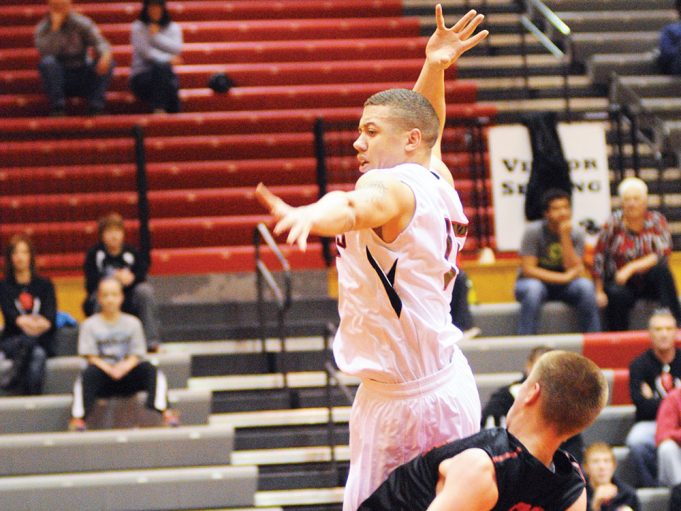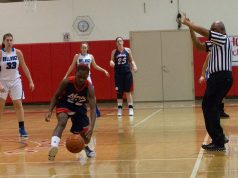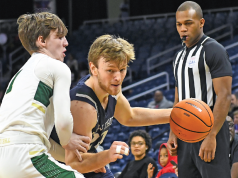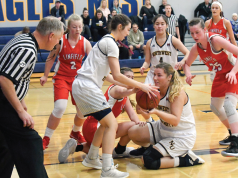Crashes should not catch basketball officials by surprise. That’s a mantra from Jon Levinson, NCAA women’s basketball secretary-rules editor, and assigner for the Patriot and Northeast conferences for D-I, as well as D-II and D-III leagues. There are many considerations to prepare for a bang-bang play that turns into a block or charge ruling. Preparation helps you get it right.
Levinson credits Edgar Cartotto (longtime Northeast Conference men’s and women’s coordinator, who first hired Levinson into college basketball) and Art McDonald (longtime men’s D-I official) for influencing him when he was a young official and for preparing him to get the block-charge ruling consistently right.
“I wouldn’t have known the rules without Edgar,” Levinson said. “(He and McDonald) were the first two people who talked about refereeing the defender. If you don’t know where the defender is, you can’t make the correct ruling.”
If there is a sudden crash in a block-charge situation that one of his officials misses, Levinson poses a few questions: What were you officiating prior to the situation? Were you ball watching? “You need to anticipate the action, but not what the decision will be,” he emphasized.
Because today’s players are faster, there’s an ever-increasing need to stay focused on the court. “Pick up the defender and be aware of what the offense is trying to do and get in the best position,” Levinson offered.
The play that sends him up a tree is when the defender has established legal guarding position and stays put, and the offensive player moves into the defender. If one of his officials gets that ruling wrong, Levinson delves deeper during his critique: What were you looking at before the play? “I do note ‘WDSDW? — What did she (the player) do wrong?’ — to find out what the official was thinking on the play,” he explained.
Establishing Legality
The first step to prepping for a potential block-charge ruling is establishing legal guarding position for the defender. Think about it: If she has never established legal guarding position, it can never be a charge. To establish a legal guarding position, the defender must have two feet on the playing floor and torso facing the offensive player. There is no minimum or maximum distance or time needed to get into a legal guarding position when the opponent has the ball.
NCAA and the Restricted Area
A caveat in the NCAA men’s and women’s college game is the restricted area. If legal guarding position is established before the defender moves into the arc, the ruling can still be a charge if the player has stayed with the defender or moved backward into the arc while moving to maintain legal guarding position. Otherwise, within the restricted area, the ruling is an automatic block when there is illegal contact — there can still be incidental contact. Legal guarding position cannot be established with the defender in the arc. In NCAAW, if the ballhandler starts his or her move to the basket from within the lower defensive box, then there is no restricted area arc.
Also legal in the men’s college game is verticality in the restricted area. What does that mean?
Let’s take this scenario: The ball is on the perimeter and the dribbler beats his defender going to the hoop. There’s a secondary defender in the restricted area (RA). He establishes legal guarding position. He jumps under the verticality rule — straight up, hands raised directly over his head — absorbing contact. What do you rule?
“It’s OK if he established legal guarding position in the RA and jumps vertically with his arms raised and attempts to block the shot,” Hyland observed.
What the defender can’t do in that situation, according to Hyland, is shift his body into another area. In other words, he can’t jump forward or sideways to cause contact. That becomes a block. It’s dicey. Getting the rule correct on a consistent basis takes a keen eye and knowledge of the nuance in the rules. High school officials: Don’t apply restricted arc rules and philosophies in high school games!
Double-Teaming and Traps
When a teammate comes over to help a primary defender, the block-charge scenario gets a bit more complicated. But the concept is the same: Legal guarding position must be established facing the offensive player. You may see two players assume legal guarding position in a trapping situation. When the offensive player leans in and makes significant enough contact, that’s a charge. “Traps are no free rein to bowl the defender over,” Levinson said.
If the offensive player beats his or her primary, that is the more typical scenario where a secondary defender comes into play. Once the offensive player’s head and shoulders are past the defender, the secondary defender must then assume legal guarding position to draw a charge. The second defender has an obligation to establish a legal guarding position or be called for blocking.
The Shooter
Sometimes basketball officials get excited when a shot goes up. They follow the ball rather than the play. Then they don’t see the shooter come down, where the potential for a block-charge exists.
Correctly officiating the block-charge rule is tough. It’s frequently raised as one of the most difficult decisions for basketball officials. But if you keep the core principles of legal guarding position in mind, you’ll raise your call accuracy.
What's Your Call? Leave a Comment:
Note: This article is archival in nature. Rules, interpretations, mechanics, philosophies and other information may or may not be correct for the current year.
This article is the copyright of ©Referee Enterprises, Inc., and may not be republished in whole or in part online, in print or in any capacity without expressed written permission from Referee. The article is made available for educational use by individuals.


















